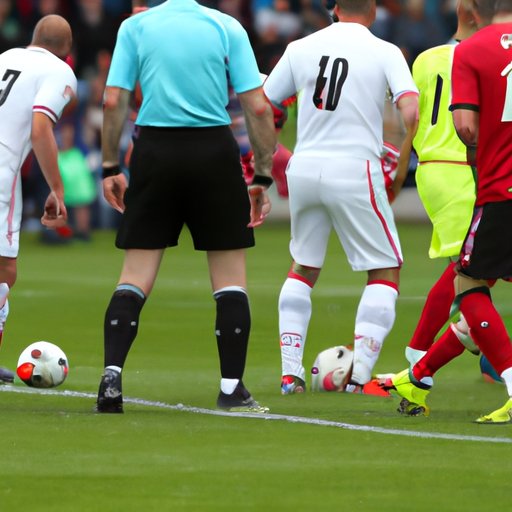Introduction
For soccer fans, understanding the offside rule can be the difference between cheering for a goal or groaning in frustration. As one of the most important rules in soccer, offside can make or break a game. However, it can also be one of the most complicated rules to master. This article will guide you through everything you need to know about the offside rule in soccer. From the basics to mastering the calls and addressing common misconceptions, we’ll reveal why understanding offside is essential for any player or fan.
Offside Rule in Soccer: A Comprehensive Guide
The offside rule in soccer is when an attacking player is closer to the opponent’s goal than both the ball and the second to last defender (usually the goalkeeper or last defender) at the moment the ball is passed to them. Being “offside” results in a free kick for the defending team. However, it’s important to understand the three key components of the offside rule: offside position, active involvement, and the timing of the pass.
The offside position is when an attacking player is nearer to the opponent’s goal line than both the ball and the second last defender. The player is not considered offside if they are level with the second last defender or the ball when the pass is made. The player is only offside during the moment the ball is played, and it doesn’t matter whether they are offside when they receive the ball.
Active involvement means that the offside player must be involved in active play, i.e., involved in the play or interfering with an opponent’s vision or movement. If the player does not touch the ball or interfere with the opponent’s vision or movement, they are not considered offside.
Timing of the pass is key to determining whether a player is offside or not. The player making the pass must release the ball before the offside player is behind the second last defender or level with that defender and the ball.
For example, imagine a player is running towards the opponent’s goal, and a teammate passes the ball towards them. If the player is behind the opponent’s second to last defender when the ball is passed to them, they are considered offside, and play stops. However, if the player is level or in front of the defender when the ball is passed to them, they are not offside, and play continues.
Mastering Offside Calls in Soccer: Tips and Strategies
Identifying when a player is offside can be challenging, even for experienced officials. However, there are some tips to help you. As a fan, focus on the positioning of the defenders and the ball. If the player receiving the ball is behind the last defender or goalkeeper when the ball is played, they are likely offside. If the player is level or ahead of the defender or goalkeeper, they are onside.
Players can avoid being called offside by varying their runs and being aware of their position in relation to the ball and the defenders. Communication with teammates can also be helpful in avoiding offside calls. By signaling their position and the location of defenders, players can coordinate their movements to avoid the offside position.
Common mistakes players make when they try to avoid being called offside include being too eager to get behind the defenders or not paying attention to their position in relation to the ball and the defenders. It’s essential to remain aware of your position on the field to avoid costly mistakes and penalties.
Unraveling the Mystery of Offside in Soccer
The offside rule can be confusing for both players and fans. One of the most common misconceptions is that a player must touch the ball to be offside. However, this is not true. A player is considered offside if they are in an offside position at the moment the ball is passed to them, regardless of whether they touch the ball or not.
Another common source of misunderstanding is the role of the goalkeeper. The goalkeeper is considered a defender and must be taken into account when determining whether a player is offside. If the goalkeeper is the second to last defender or the last defender when the ball is played, the attacker must be beyond both the ball and the goalkeeper to be onside and avoid being penalized.
To better understand the offside rule, it’s essential to practice identifying offside situations and understanding the three key components of the rule: offside position, active involvement, and timing of the pass. Many resources are available to help players and fans become more familiar with the rule, including videos, articles, and tutorials.
Everything You Need to Know About Offside in Soccer
Understanding the offside rule is critical for players and fans alike. From the basics to mastering the calls and addressing common misconceptions, we’ve covered everything you need to know about offside in soccer. Remember, a player is offside if they are in an offside position when the ball is played, and they are closer to the opponent’s goal line than both the ball and the second to last defender. Practicing identifying offside situations, communicating with teammates and paying attention to your position on the field can help you avoid being called offside and give you a better understanding of the game.

Offside In Soccer: Why This Rule Is So Controversial
The offside rule is one of the most controversial rules in soccer, with fans and players alike disagreeing on whether certain calls were correct. One of the most challenging aspects of the offside rule is the timing of the pass, which can lead to close calls and ambiguity in deciding whether a player is offside or not.
However, the offside rule is critical for maintaining the fairness and balance of the game, ensuring that attackers do not gain an unfair advantage by positioning themselves in front of the defenders. By enforcing the offside rule, soccer officials can help to maintain competitive balance and keep games fair and exciting for players and fans alike.
To address controversies surrounding the offside rule, some soccer experts have suggested potential changes or modifications to the rule. These could include altering the criteria for determining offside or using technology to aid officials in making more accurate calls.
The Evolution of the Offside Rule in Soccer
The offside rule has evolved greatly over the years, from its earliest origins to modern-day soccer. In the past, the rule was much simpler, with players deemed offside if they were between the ball and the goal when the ball was played. Over time, however, the rule has become more complex to prevent attackers from gaining an unfair advantage.
Recent modifications to the offside rule include clarifications about the role of the goalkeeper and the timing of the pass. Some soccer experts have called for additional changes, such as using technology to help enforce the offside rule more accurately and consistently across different leagues and matches.
Offside and VAR: How Technology Is Affecting Soccer’s Most Important Rule
In recent years, video assistant referee (VAR) technology has been introduced to help officials make more accurate calls, including for offside situations. VAR technology uses cameras and sensors to scan the field and provide officials with real-time feedback on potential offside calls, allowing them to make more informed decisions.
While VAR has helped to reduce some of the ambiguity and controversy surrounding offside situations, it is not without its challenges. Critics argue that VAR can be time-consuming and disrupt the natural flow of the game. Additionally, not all leagues or matches use VAR, leading to inconsistencies in the enforcement of the offside rule.
Conclusion
Understanding the offside rule in soccer can be challenging but essential for players and fans. By mastering the rule’s components, identifying offside situations, and avoiding common mistakes, players can prevent offside calls and gain a deeper appreciation for the sport. While controversies and challenges remain, the offside rule remains one of soccer’s most critical and fascinating aspects, shaping the way the game is played and enjoyed by millions of fans worldwide.
